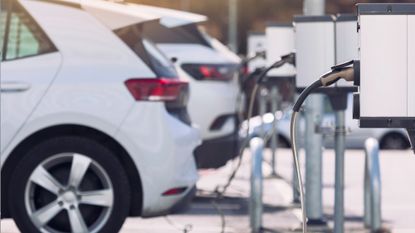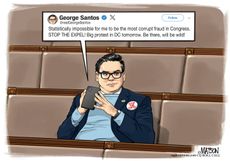Electric vehicles: Automakers fail to dent Tesla’s lead
The demand for EVs remains high, but sale numbers show a dip

The smartest insight and analysis, from all perspectives, rounded up from around the web:
"Normally a 50% increase in sales is considered very good," said Jack Ewing in The New York Times. But when it comes to electric vehicles, it’s an alarming slowdown. EVs are still selling "faster than any other major category of automobiles." They now account for 8% of the total market for new cars sold in the U.S., up from 6% a year earlier. But recently released sales numbers show growth dipping from a year ago, when EV sales were rising at a pace of about 70% year. The data cast "doubt on whether generous federal tax credits for EV buyers were working as well as policymakers had hoped," and General Motors and Ford, who have pledged billions toward manufacturing more battery powered cars, seem noticeably anxious. Ford recently paused $12 billion in planned spending on EV production, while GM has pushed back launches of a slate of electric trucks and SUVs.
Automakers’ anxiety is understandable considering how much they’re losing on each sale, said The Wall Street Journal in an editorial. Ford lost $62,016 on each EV it sold in the third quarter. Electric pickup maker Rivian lost $30,648. But the ultimate loss leader is Lucid Motors, which reported a staggering $227,802 loss per car sold. "Who would have thought that millions of Americans would not be lining up to pay $125,000 for an EV?" I guess not the investors who bought the EV hype when Lucid reached a $91 billion market value in 2021. It seems the rubber has met the road. Lucid isn’t the only unaffordable EV, said Tim Levin in Business Insider. The average price paid for an EV in September was $50,683, with "scant electric options in the sub $40,000 range." And there is just "a dwindling supply of early adopters willing to pay up to participate in the EV revolution."
Subscribe to The Week
Escape your echo chamber. Get the facts behind the news, plus analysis from multiple perspectives.

Sign up for The Week's Free Newsletters
From our morning news briefing to a weekly Good News Newsletter, get the best of The Week delivered directly to your inbox.
From our morning news briefing to a weekly Good News Newsletter, get the best of The Week delivered directly to your inbox.
Don’t believe the panic about waning demand, said Jesse D. Jenkins in Heatmap News. "Ominous headlines about the 'slowing' EV market are more a story about Ford and GM" and their business follies. While they disregarded Tesla for years, it built such a huge EV lead that it "had ample time to bring down manufacturing costs." Then Tesla cut prices in a "defensive" move that hit rivals just as high interest rates began making buyers more cost-conscious. "These shifting market realities seem to have caught several legacy automakers off guard and forced a major refocus on reducing cost of production."
The charging problem can’t be dismissed, said David Gelles in The New York Times. On a reporting trip to Minnesota this summer, I rented an all-electric Volvo C40 Recharge crossover that "promised 200 miles in range." My destination was 154 miles away. But "after two hours of driving, the Volvo’s battery was below 50%." I pulled over to recharge but, after waiting 30 minutes, "I was dismayed to see that the battery had gained just 2%." I’d have to wait until 1 a.m. for the car to fully charge and that was the only charger within 50 miles. I eventually had to call Hertz to get the car towed. "So much for my EV road trip."
This article was first published in the latest issue of The Week magazine. If you want to read more like it, you can try six risk-free issues of the magazine here.

Continue reading for free
We hope you're enjoying The Week's refreshingly open-minded journalism.
Subscribed to The Week? Register your account with the same email as your subscription.
Sign up to our 10 Things You Need to Know Today newsletter
A free daily digest of the biggest news stories of the day - and the best features from our website
-
 Today's political cartoons - December 2, 2023
Today's political cartoons - December 2, 2023Cartoons Saturday's cartoons - governors go Gotham, A.I. goes to the office party, and more
By The Week US Published
-
 10 things you need to know today: December 2, 2023
10 things you need to know today: December 2, 2023Daily Briefing Death toll climbs in Gaza as airstrikes intensify, George Santos expelled from the House of Representatives, and more
By Justin Klawans, The Week US Published
-
 5 hilarious cartoons about the George Santos expulsion vote
5 hilarious cartoons about the George Santos expulsion voteCartoons Artists take on Santa versus Santos, his X account, and more
By The Week US Published
-
 Companies cut back on benefits
Companies cut back on benefitsFeature And more of the week's best financial insight
By The Week Staff Published
-
 OpenAI: A boardroom coup wrenches the AI world
OpenAI: A boardroom coup wrenches the AI worldFeature OpenAI employees are asking the board to resign
By The Week US Published
-
 Bank accounts caught up in red tape
Bank accounts caught up in red tapeFeature And more of the week's best financial insight
By The Week US Published
-
 Self-service tills: the backlash begins
Self-service tills: the backlash beginsTalking Point Booths, the supermarket chain known as the 'Northern Waitrose', has decided to reintroduce humans to the checkout process
By The Week UK Published
-
 Don’t count on working forever
Don’t count on working foreverFeature And more of the week's best financial insight
By The Week US Published
-
 Bankman-Fried: A con artist's day of reckoning
Bankman-Fried: A con artist's day of reckoningFeature How the crypto king's downfall might actually begin to restore trust in the crypto market
By The Week Staff Published
-
 Bidenomics: A roaring economy still filled with unease
Bidenomics: A roaring economy still filled with uneaseFeature Americans are doing better financially but still lack confidence in the economy
By The Week US Published
-
 It’s too easy to lose health insurance
It’s too easy to lose health insuranceFeature And more of the week's best financial insight
By The Week US Published










